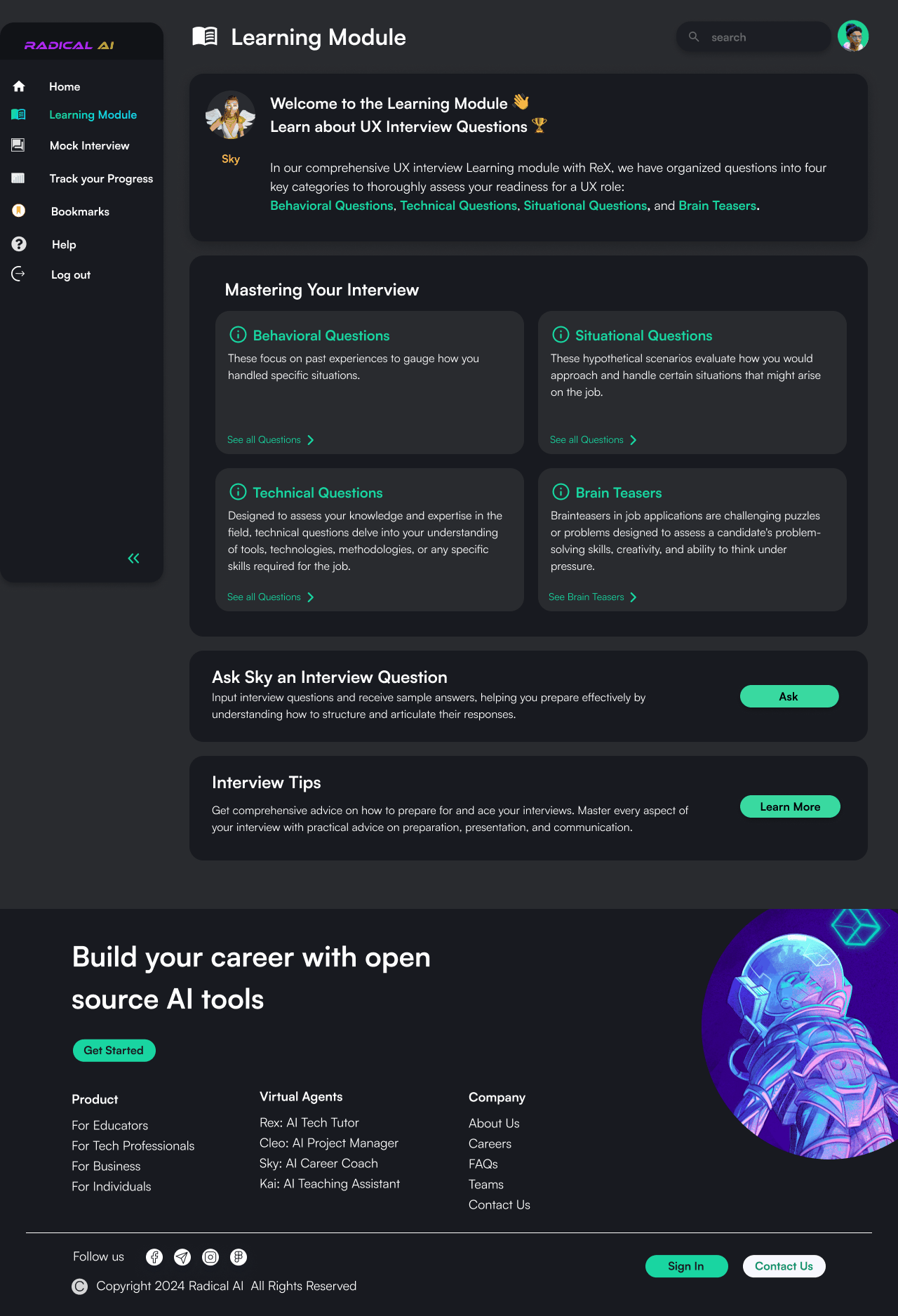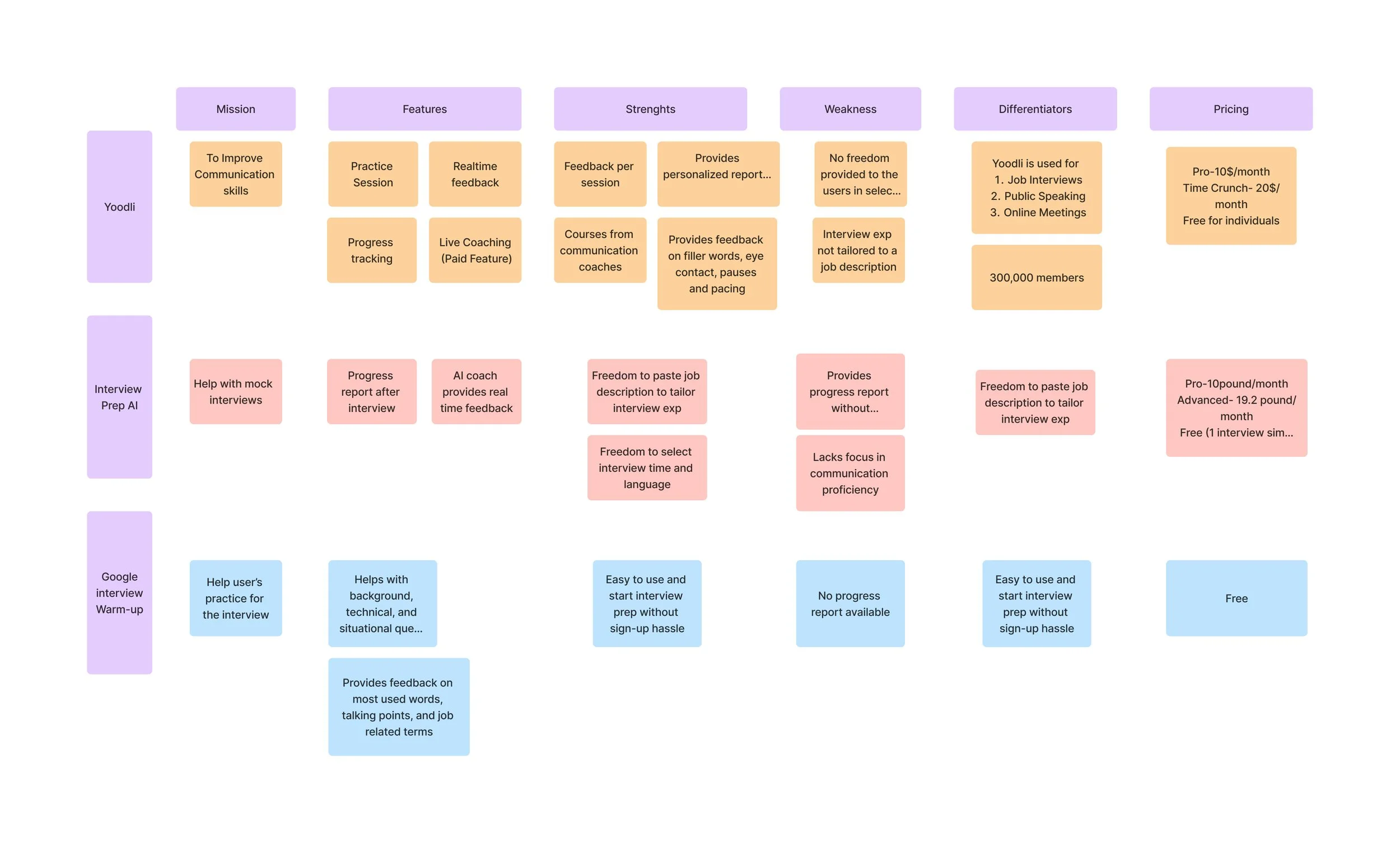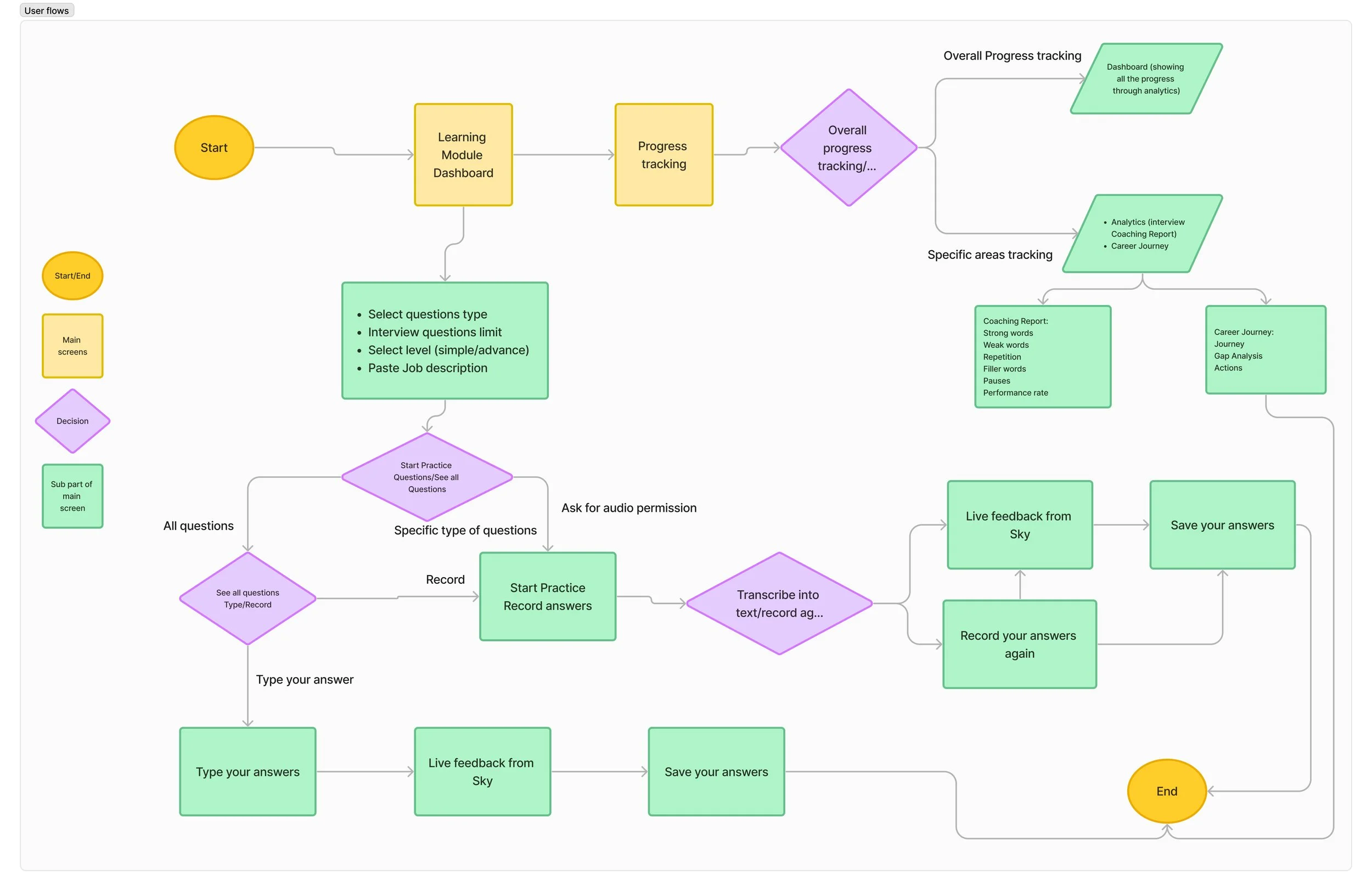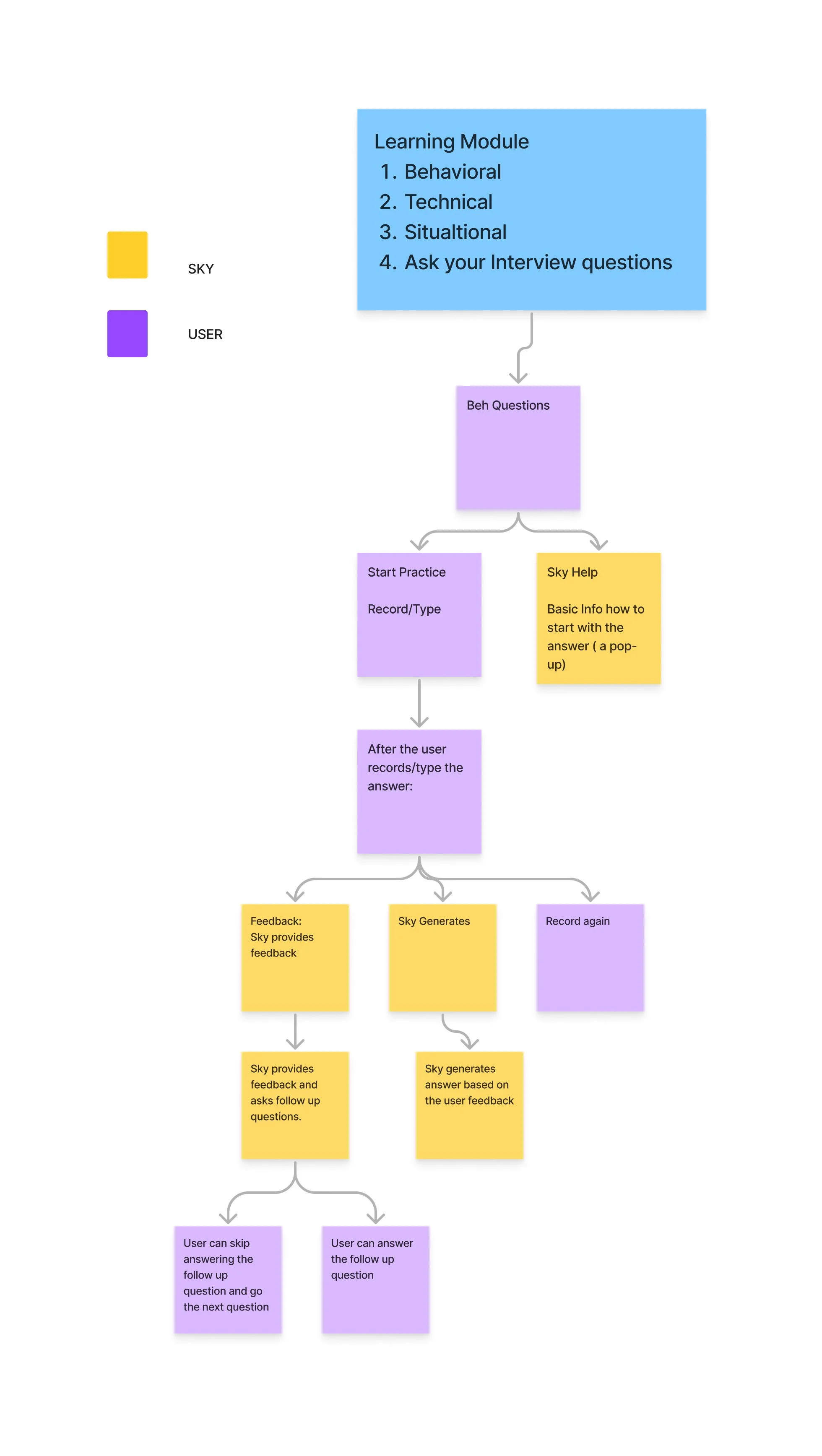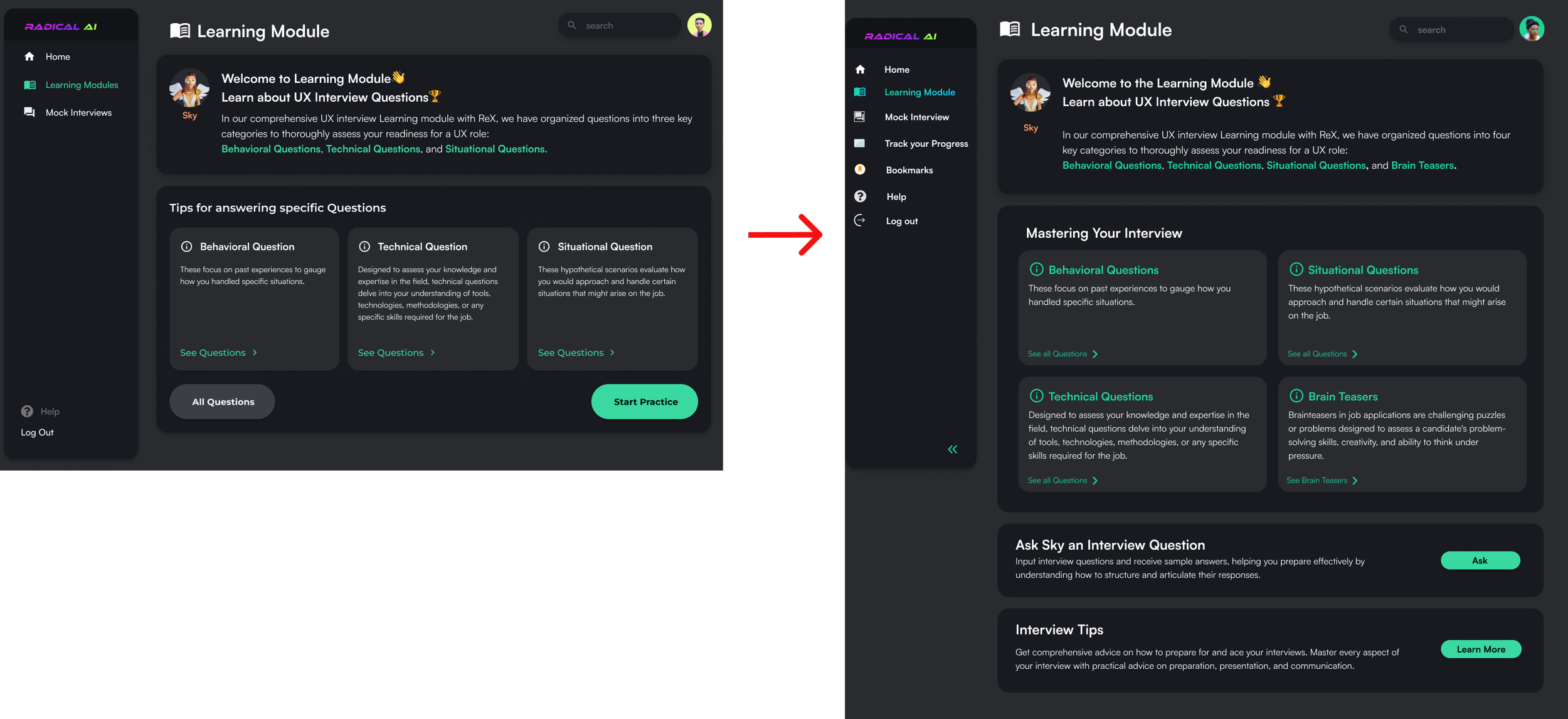Radical AI
Designed “Sky”, an AI Career Coach platform focused on personalized tech interview preparation.
Role: Team Lead, Project Management, Product Design, UX Design, UI Design
Team: 6 UX/Product Design Interns, Lead Product Designer, Software Developer, and Company Host
Timeline: Apr 2024-Jun 2024
Tools used: Figma, Fig Jam, Miro
Collaboration Channel: Gather Workspace, and Slack
Introduction
Sky, the AI Interview Prep Coach, is set to receive a major upgrade, moving from Version 1.0 to Version 2.0. This update aims to boost user engagement, offer more personalized experiences, and provide tech professionals with enhanced tools for effective interview preparation. Version 2.0 will introduce a revamped user interface, improved user experience, new and innovative features, and a strong emphasis on accessibility, ensuring that the platform meets the diverse needs of all users.
Business Goals:
Enhance Aesthetics: Create a visually inviting and intuitive interface that simplifies navigation and encourages user engagement.
Increase Personalization: Customize the interview preparation process to align with individual user needs, preferences, and career goals.
Expand Content and Features: Introduce dynamic, community-driven content and innovative features like gamification to enrich the user experience.
Improve Accessibility: Ensure the platform is fully accessible, providing an inclusive experience for all users, including those with disabilities.
Problem Statement:
How might we empower tech professionals to excel in mock interviews by providing personalized experiences, actionable feedback, and enhanced user engagement?
My responsibilities as a team lead
User-Centered Solutions
1
In addition to behavioral, situational, and technical questions, we have integrated challenging brainteaser questions. We also introduced the 'Ask Sky an Interview Question' feature, which allows users to input specific interview questions and receive sample answers.
2
Included Brainteaser questions with Rapid Redesign, Interactive Scenario, User Persona Matching, and Wireframe Puzzle games to enhance problem-solving skills.
3
Enabled AI-driven dynamic question generation to offer varied and relevant interview questions. And incorporated a voice recording feature that allows users to record and review their answers for self-assessment.
4
Provided detailed feedback reports and in-depth analysis to help users understand their strengths and areas for improvement.
5
Developed visual guides for personalized learning journeys, tracking user progress dynamically.
MY Design Approach
Phase 1- Research
Competitive Analysis
Following the initial meeting with the Lead Product Designer, where I gained a clear understanding of the assigned business goals, I initiated a Competitive Analysis, focusing on three key companies within the industry.
Google Interview Warm-Up is a versatile and accessible option for those looking for a general interview preparation tool.
Yoodli excels in providing specialized preparation, particularly for tech industry candidates aiming for top companies, with a strong emphasis on communication skills.
Interview Prep AI stands out for its interactive, live AI practice sessions and instant feedback, catering to users seeking a more hands-on, premium experience.
User Interviews
The primary objectives of this user interview were to uncover:
What resources do users practice for interviews (e.g., online platforms, books, coaching)
How often do user practice mock interviews?
If a user has a routine for preparing for a mock interview?
What biggest challenges a user faces when preparing for mock interviews?
What specific aspects of mock interviews do user find most difficult (e.g. technical questions, behavioral questions, communication skills)?
What kind of feedback user receive after the interview preparation?
What kind of support does a user need to help improve mock interview performance?
How do a user envision a career progressing for securing a full-time role?
How confident do a user feel about their interview skills at present?
Users face challenges like managing anxiety, balancing preparation with other commitments, and staying motivated.
Users often struggle with technical questions, especially under time pressure, and find behavioral questions and effective communication difficult.
Many users find it hard to establish consistency.
Users desire for more personalized, actionable insights as the feedback is generally seen as too generic.
Insights
User Persona
User Journey
Phase 2- User Flows
After identifying users' pain points and goals, I designed tailored user journeys that effectively guide them toward achieving their objectives. By illustrating how pages connect and relate, I prioritized content to create a clear and logical flow, enabling users to navigate the website more effortlessly.
Brainstorming Flows:
Following a collaborative brainstorming session with the lead product designer, where we discussed the question-answer flow and user feedback process, I crafted the user flows. We agreed to implement an interactive real-time feedback mechanism that adapts to user performance, complemented by a comprehensive, detailed feedback report.
Phase 3- Design Solutions
After gaining insights into the users' pain points, motivations, and goals, I created several sketches and developed design solutions for Version 2 tailored to address users’ needs effectively.
Feedback Report: Version 1
Feedback Report: Version 2
Break down of the feedback report into 5 different sections: Version 2
Progress Tracking: Version 1
Progress Tracking: Version 2
After
Before
Learning Module: Version 2
Learning Module: Version 1
Voice Recording Feature: Version 1
Voice Recording Feature: Version 2
Three new features were added to Version 2 to expand the current product and enrich the user experience.
AI-driven Question Generation added to Version 2
Play bar and Record again Features were added to Version 2
Brainteaser Questions were added in Version 2.
Phase 4- A/B Testing and Findings
Target Users:
Tech professionals at various stages of their careers seeking to prepare for job interviews.
Hypothesis 1:
Users who use Learning Module Version 2 will have higher engagement, complete more practice sessions, and will also enhance their problem-solving skills compared to users who use Version 1.
Metrics:
User Engagement:
Time spent on the module
User Satisfaction:
Positive feedback through usability tests.
Satisfaction ratings (on a scale of 1-5)
Control
Variant
70% increase in user engagement
Positive Reception: Users found the overall design of Version 2 to be more intuitive and aesthetically pleasing, contributing to a better learning experience.
Brain Teaser Popularity: The new brain teaser category was well-received
Instructional Improvement: Users found the instructions for brain teasers to be too lengthy.
Findings:
Users who receive detailed feedback in Version 2 will be more motivated to increase the frequency of their practice sessions compared to users who receive general feedback in Version 1.
Hypothesis 2:
Metrics:
User Feedback:
How satisfied were users with the detailed feedback provided? (Rate on a scale from 1-10)
Ask users if they intend to return and continue using the platform based on the feedback they received.
Control
Variants
80% satisfaction rate
Positive Perception: Detailed feedback report motivates users to practice more frequently to improve their skills.
Contextual Feedback: Users desire more context and explanation for their overall performance score.
Findings:
Users who use the graphical progress tracking layout Version 2 will have a better understanding of their progress, feel more motivated, and engage more with the learning module compared to users who use Version 1.
Hypothesis 3:
Metrics:
User Understanding:
Ability to identify strengths and weaknesses and progress score.
Control
Variant
60% increase in user understanding
Clarity and Simplicity: Users found the design more intuitive and but lacked a clear understanding of how it was calculated.
Visual Representation: Users found the visual elements, such as graphs and charts, effective in monitoring their progress.
Findings:
Handoff to Lead Product Designer
After conducting thorough A/B testing and deriving key insights, I compiled a comprehensive report of the findings, including detailed recommendations for future iterations. I then handed over the project to the Lead Product Designer, ensuring a smooth transition by documenting all relevant design decisions and outlining potential next steps. My internship concluded at this stage, but I remain proud of the foundation I helped build for the project's continued success
Takeaways
Users value detailed, personalized feedback that directly addresses their specific responses. This type of feedback motivates them to practice more and drives them to refine and enhance their skills continuously.
Simplifying instructions and using video tutorials can significantly improve the user experience by reducing confusion and allowing users to engage with content more quickly.
Incorporating gamification elements like points and badges can increase user engagement and motivation, especially in learning environments.
Future Directions
Enhance Brain Teaser Experience:
Video Tutorials: Providing video tutorials to the users will be more engaging and effective explanations of brain teasers.
Difficulty Levels: Offering different difficulty levels for brain teasers to cater to users with varying skill levels will enhance users overall problem-solving skills.
Gather More User Feedback:
Targeted Surveys: Conducting targeted surveys will help gather more detailed feedback on specific features, such as the brain teasers, progress tracking, and overall user experience.
Expand Progress Tracking Functionality:
Detailed Insights: Providing more detailed insights into user performance, such as comparisons to benchmarks or peer groups will motivate them to improve their interview skills.
Gamification: Incorporating gamification elements, such as points, badges, or leaderboards, will motivate users and encourage them to continue engagement.

